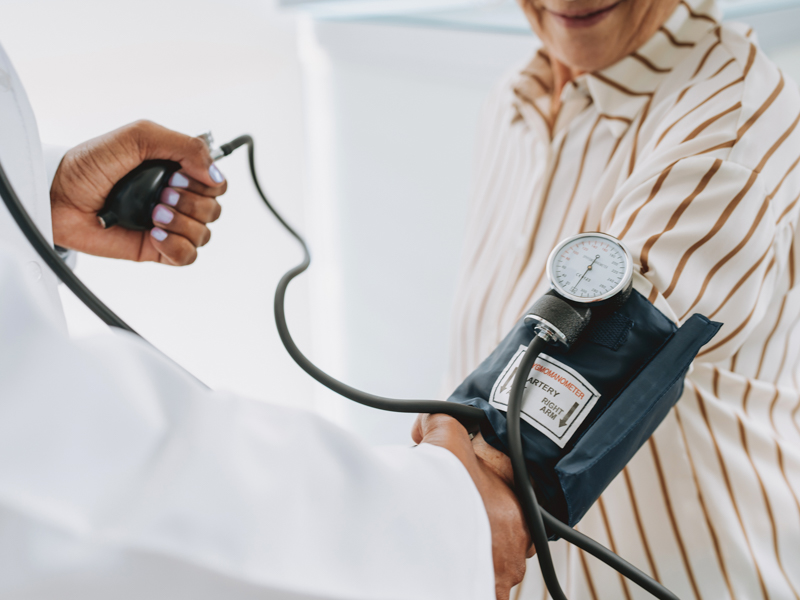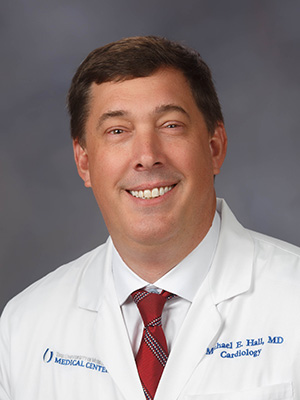UMMC professor emeritus leads development of new hypertension guideline

A new joint guideline from the American Heart Association and the American College of Cardiology calls for earlier diagnosis and treatment of hypertension to reduce risk of heart attack, stroke, kidney disease, cognitive decline and dementia.
The new guideline reflects several major changes since 2017, including use of the American Heart Association’s PREVENT (Predicting Risk of cardiovascular disease EVENTs) risk calculator to estimate cardiovascular disease risk. It also provides updated guidance on medication options, including the early treatment for high blood pressure to reduce the risk of cognitive decline and dementia; use of specific medications including the possible addition of newer therapies such as GLP-1 medications in those with overweight or obesity; and recommendations for managing high blood pressure before, during and after pregnancy to reduce the risk of preeclampsia.
Also new this year is the link between high blood pressure and brain health. High blood pressure can damage small blood vessels in the brain, resulting in memory problems and long-term cognitive decline.

“Now there is clear evidence that lowering blood pressure can reduce the risk of dementia,” said Dr. Daniel W. Jones, dean and professor emeritus of the University of Mississippi Medical Center School of Medicine and chair of the guideline writing committee. Jones, who served as chancellor at the University of Mississippi from 2009 to 2015, was president of the American Heart Association from 2007 to 2008.
“High blood pressure is the most common and most modifiable risk factor for heart disease,” Jones said. “By addressing individual risks earlier and offering more tailored strategies across the lifespan, the 2025 guideline aims to aid clinicians in helping more people manage their blood pressure and reduce the toll of heart disease, kidney disease, Type 2 diabetes and dementia.”
The new clinical guideline, which replaces guidance written in 2017, was published Thursday in the American Heart Association’s peer-reviewed journals Circulation and Hypertension and in JACC, the flagship journal of the American College of Cardiology.
Dr. Michael Hall, chair of the UMMC Department of Medicine, said Jones’ role in chairing the writing committee shows the Medical Center’s global influence on hypertension care.

“His influence is particularly important because this guideline is something the rest of the world pays attention to,” Hall said.
Hall, who worked for Jones early in his career, said years of providing care to patients with high blood pressure are reflected in Jones’ writing on hypertension.
“He has real-world experience and truly practices what he preaches,” Hall said of Jones, who has researched hypertension in Mississippi as well as South Korea. “His writing is based on science as well as the observations made in caring for thousands of patients.”
High blood pressure is the leading cause of death in the U.S. and around the world. More than 43.9% of adult Mississippians – nearly 1 million – had hypertension in 2021, Mississippi State Department of Health statistics show. Among Mississippians older than 65, the hypertension rate was 73.3% that year.
The blood pressure criteria of the 2017 guideline are unchanged. That defines normal blood pressure as less than 120/80, elevated blood pressure as 120-129/80, stage 1 hypertension as 130-139/80-89 and stage 2 hypertension as 140/90 or higher.
“This updated guideline is designed to support health care professionals — from primary care teams to specialists, and to all clinicians across health systems — with the diagnosis and care of people with high blood pressure. It also empowers patients with practical tools that can support their individual health needs as they manage their blood pressure, whether through lifestyle changes, medications or both,” Jones said.
Treatment for hypertension should include lifestyle changes and medications as appropriate. “There's an abundance of studies that show the safety of lowering a patient’s blood pressure to 120/80 if it is done slowly and over a prolonged period,” Jones said.
The new guideline reaffirms the critical role a healthy lifestyle plays in preventing and managing high blood pressure, and it encourages health care providers to work with patients to set realistic, achievable goals. Healthy behaviors such as those in Life’s Essential 8, the American Heart Association’s metrics for heart health, remain the first line of care for all adults.
Blood pressure-related guidance includes:
Limiting sodium to less than 2,300 mg per day, or about 1 teaspoon of table salt, moving toward an ideal limit of 1,500 mg per day, or about a third of a teaspoon.
Maintaining a healthy weight.
Following a heart-healthy eating plan such as DASH, which features a diet high in vegetables, fruits, whole grains, legumes, nuts, seeds, lean meats and poultry and low-fat or nonfat dairy foods.
Increasing physical activity, including aerobic exercise and resistance training, to at least 75 to 150 minutes each week.
Managing stress with exercise and stress-reduction techniques such as meditation, breathing control or yoga.
Consuming no alcohol or reducing drinks to no more than two a day for men and one a day for women.
“It is important for people to be aware of the recommended blood pressure goals and understand how healthy lifestyle behaviors and appropriate medication use can help them achieve and maintain optimal blood pressure. Prevention, early detection and management of high blood pressure are critical to long-term heart and brain health, which means longer, healthier lives,” Jones said.
The guideline, led by the American Heart Association and American College of Cardiology Joint Committee on Clinical Practice Guidelines, was developed in collaboration with and endorsed by 11 other health care organizations: the American Academy of Physician Associates; the American Association of Nurse Practitioners; the American College of Clinical Pharmacy; the American College of Preventive Medicine; the American Geriatrics Society; the American Medical Association; the American Society of Preventive Cardiology; the Association of Black Cardiologists; the National Medical Association; the Preventive Cardiovascular Nurses Association; and the Society of General Internal Medicine.


